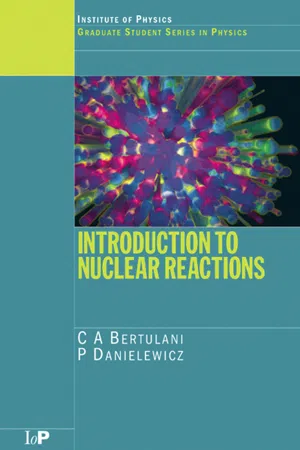
- 542 pages
- English
- ePUB (mobile friendly)
- Available on iOS & Android
Introduction to Nuclear Reactions
About this book
Until the publication of Introduction to Nuclear Reactions, an introductory reference on nonrelativistic nuclear reactions had been unavailable. Providing a concise overview of nuclear reactions, this reference discusses the main formalisms, ranging from basic laws to the final formulae used to calculate measurable quantities.Well known in their fields, the authors begin with a discussion of scattering theory followed by a study of its applications to specific nuclear reactions. Early chapters give a framework of scattering theory that can be easily understood by the novice. These chapters also serve as an introduction to the underlying physical ideas. The largest section of the book comprises the physical models that have been developed to account for the various aspects of nuclear reaction phenomena. The final chapters survey applications of the eikonal wavefunction to nuclear reactions as well as examine the important branch of nuclear transport equations.By combining a thorough theoretical approach with applications to recent experimental data, Introduction to Nuclear Reactions helps you understand the results of experimental measurements rather than describe how they are made. A clear treatment of the topics and coherent organization make this information understandable to students and professionals with a solid foundation in physics as well as to those with a more general science and technology background.
Frequently asked questions
- Essential is ideal for learners and professionals who enjoy exploring a wide range of subjects. Access the Essential Library with 800,000+ trusted titles and best-sellers across business, personal growth, and the humanities. Includes unlimited reading time and Standard Read Aloud voice.
- Complete: Perfect for advanced learners and researchers needing full, unrestricted access. Unlock 1.4M+ books across hundreds of subjects, including academic and specialized titles. The Complete Plan also includes advanced features like Premium Read Aloud and Research Assistant.
Please note we cannot support devices running on iOS 13 and Android 7 or earlier. Learn more about using the app.
Information
Chapter 1
Classical and quantum scattering
1.1 Experiments with nuclear particles
Table of contents
- Cover
- Title Page
- Copyright Page
- Table of Contents
- Preface
- 1 Classical and quantum scattering
- 2 The partial-wave expansion method
- 3 Formal scattering theory
- 4 Compound nucleus reactions
- 5 Fusion and Fission
- 6 Direct reactions
- 7 Nuclear reactions in the cosmos
- 8 High energy collisions
- 9 Relativistic collisions